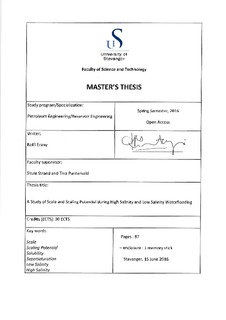| dc.description.abstract | Formation damage has been observed to be one of the severe problems during field life operation. In the waterflood projects, proper design water injection at the beginning of field life is crucial to minimize effects of incompatibility between source water/formation water. If the incompatibility condition is created then the scale precipitation might occur. In many oil/gas field cases, detrimental loss production or even well abandonment are required. The supersaturation condition is one of the critical factors that cause formation. If the condition is reached, insoluble salts will precipitate through nucleation and crystal growth process [1].
In this thesis, literature studies are conducted to gain deeper understanding about the scales behaviors, types and how to inhibit and remove them. In addition, PHREEQC simulator is run to study incompatibility waters (FW/Injected water) with variation of temperature, pressure, mixing ratio and injected water salinity. Temperature is set from 25OC to 150OC. Pressure is run at 10atm, 50atm, and 100atm. The mixing ratios vary at 30%, 50%, and 70% of sea water. The injected water is sea water (SW), diluted 10 times SW and 50 times diluted SW. In addition, the effects of heterogeneity reservoir are studied to see the influences to scale formation. Subsequently, a study of scale prevention and removal are also performed to reduce impact on scale precipitation
The study shows that the scale potential is mainly dominated by Sulfate Scales (CaSO4, BaSO4, SrSO4) and Carbonate Scales (CaCO3, MgCa(CO3)2). The solubility of BaSO4 scale increases with temperature and vice versa. It is observed that CaSO4 (s) is extremely precipitated at high temperature followed by carbonate scales dissolution. Pressure drops from 100atm to 10atm creates insoluble salt precipitation, extremely found for carbonate scales with twice of solubility decreasing. The increase in mixing ratios leads to more scale precipitation, observed in an increase from 50%SW to 70%SW yields a triple reduction of MgCa(CO3)2 solubility. Injected water salinity reveals the significant impact on potential scale precipitation. Lower potential scales were observed in the mixing of FW/diluted SW than FW/SW. Most of the scales can be dissolved into solution, except BaSO4 which is still precipitated out even in the mixing FW/diluted 50 times SW. Lastly, the heterogeneity of the reservoir influences the development of mixing incompatible waters in the reservoir where higher degree of heterogeneity will result in more scale precipitation.
By doing this study, it can be inferred that the less scale potential occurs by lowering salinity of injected water. It is related to the Low Salinity water injection that has been established recently, it offers not only the significant oil enhancement but also lower scaling potential than High Salinity water injection. | nb_NO |
